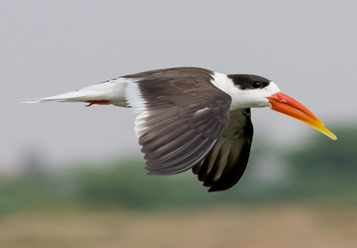

9th July 2022 (7 Topics)
Context
Three Indian skimmers, an endangered bird species on the International Union for Conservation of Nature (IUCN) list, were spotted in Nal Sarovar Bird Sanctuary (NSBL)—the famous wetland near Ahmedabad.
Background
About Indian Skimmers
- Indian Skimmer (Rynchops albicollis) is a waterbird species.
- In India, the species can be sighted near the Chambal River in Central India, in few parts of Odisha and in Andhra Pradesh.
- IUCN Red List Status- Endangered
- CITES Status: Not listed.
- The Indian skimmer grows to a length of 40-43 cm.

- It has black upper parts, white forehead, collar and lower parts, long, thick, deep orange bill with a yellow tip and longer lower mandible.
- In flight, it has a white trailing-edge to wing and a short forked tail with blackish central feathers.
- It breeds colonially on large, exposed sand-bars and islands between February and May.
- It feeds on surface-dwelling fish, small crustaceans and insect larvae.
- It emits a nasal kapor kip notes, particularly in flight and when disturbed.
- They have last been recorded in areas of Prayagraj in Uttar Pradesh, Kakinada in Andhra Pradesh and Porbandar, Jamnagar and Rann of Kutch in Gujarat.
- The bird’s range includes the Indian subcontinent and Southeast Asia.
Major threats
- Habitat degradation. Exploitation and degradation of rivers and lakes through fishing, transportation, domestic use, irrigation schemes and pollution from agricultural and industrial chemicals are largely responsible for the decline of this species as these factors have reduced reproductive and foraging success.
- Excessive and widespread increases in disturbance. The damming of the Chambal River, in upstream Rajasthan, has adversely affected its population at National Chambal Sanctuary, Uttar Pradesh, due to the dropping water levels allowing predators and livestock access to breeding islands (Sundar, 2004).
- Predation by corvids like House crows (Corvus splendens), presence of stray and domestic dogs has been known to decimate breeding colonies.
|
Nal Sarovar Sanctuary
|
International union for Conservation of nature (IUCN)
- IUCN is a membership union uniquely composed of both government and civil society organisations.
- Created in 1948,it is the global authority on the status of the natural world and the measures needed to safeguard it.
- It is headquartered in
- TheIUCN Red List of Threatened Species is the world's most comprehensive inventory of the global conservation status of plant and animal species.
- It uses a set of quantitative criteria to evaluate the extinction risk of species. These criteria are relevant to most species and all regions of the world.
- The IUCN Red List Categories define the extinction risk of species assessed.Nine categories extend from NE (Not Evaluated) to EX (Extinct). Critically Endangered (CR), Endangered (EN) and Vulnerable (VU) species are considered to be threatened with extinction.
- It is recognized as the most authoritative guide to the status of biological diversity.
- It is also a key indicator for the SDGsand Aichi Targets.

More Articles


